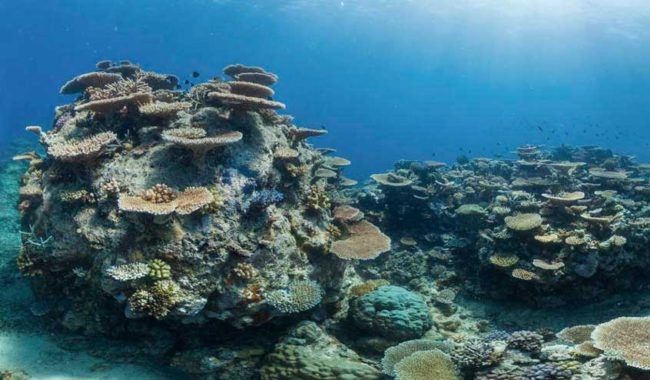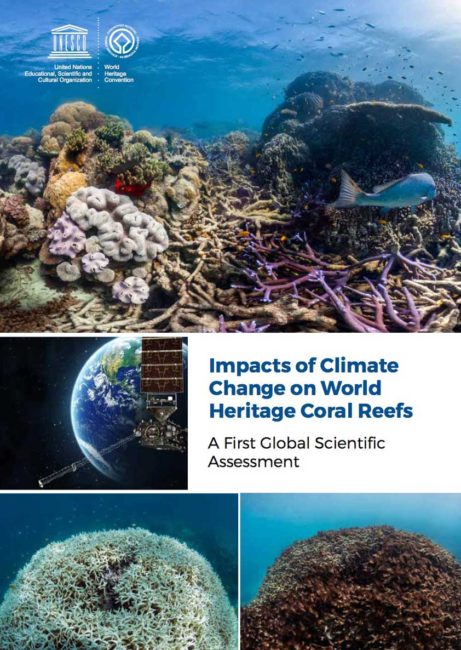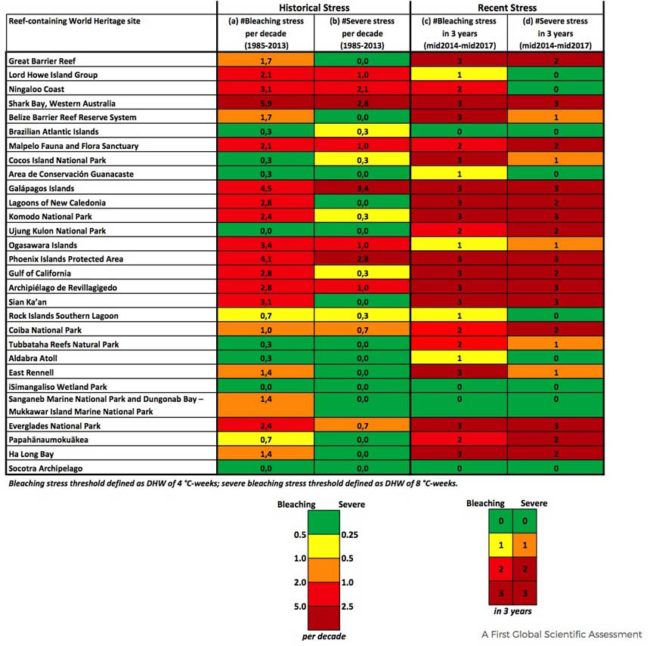
The canary in the coal mine, the world’s Coral Reefs are now in extreme distress. Not too long ago I was blogging about the unprecedented back-to-back mass bleaching event that has taken place on Australia’s Great Barrier Reef. The actual scope, the big picture here, is that it is not simply one famous Coral Reef that is in trouble, almost all of them are, because what is happening is global in scale.
A few days ago on 23rd June UNESCO released their first global scientific assessment of the climate change impacts on World Heritage coral reefs. They report that out of the 29 World Heritage Reefs, already 21 of them are suffering from repeated extreme heat stress, and that has triggered some of the worst bleaching events ever recorded. This includes all the iconic sites such as the Great Barrier Reef (Australia), Papahānaumokuākea (USA), the Lagoons of New Caledonia (France) and Aldabra Atoll (Seychelles). They estimate is that by 2100 they will have ceased to exist if nothing is done to address Global Warming.
Click this link to find the UNESCO report.
Report Summary: “Impacts of Climate Change on World Heritage Coral Reefs”

The report itself is only 16 pages long, so you might wonder just how scientific it is. The answer is very. The appendix at the end lists the 40 peer-reviewed scientific papers that are cited to backup the content.
It has been split up into six sections as follows:
- Coral Reef Systems on UNESCO’s World Heritage List
- Mass Coral Bleaching and its Implications for World Heritage
- Observed Heat Stress and Bleaching Frequency in Reef- Containing World Heritage Properties
- Projected Future Heat Stress on Reef-Containing World Heritage Properties under Two Climate Change Scenarios
- Summary and Solutions
- Additional Research
Observations
In essence, what is known and has been observed is identified within section 3 …
Seventy two percent of World Heritage reef properties (21 of 29) have been exposed to severe and/or repeated heat stress during the past three years. Within the three years of the current global bleaching event (mid 2014-mid 2017), 18 World Heritage reefs (62%) were in the highest impact category (dark red) at either one or both stress levels
… Coral mortality during the third global bleaching event has been among the worst ever observed, including at World Heritage reefs; e.g., Great Barrier Reef (Australia), Papahānaumokuākea (USA) and Aldabra Atoll (Seychelles).

Solutions?
Bleaching events are becoming more common in recent years due to the increased heat stress because of Global Warming, and so the solution is the rather obvious one …
this assessment finds that drastic reductions in CO2 emissions are essential – and the only real solution – to giving coral reefs on the World Heritage List a chance to survive climate change.
Until now, the focus for World Heritage sites in maintaining the Outstanding Universal Value of their key features has been on maintaining integrity through on-site management and pressures, and national or regional enabling legislation. Efforts to restore resilience and reduce local human stressors remain necessary but are no longer sufficient For the first time, a ubiquitous global threat – heat stress sufficient to cause frequent severe bleaching and mortality – now threatens the OUV of World Heritage sites in a way that cannot be resolved through local management alone. The only viable solution is for all countries with World Heritage coral reefs to not only act to reduce local stressors but also to reduce their greenhouse gas emissions to net zero, along with supporting active CO2 removal from the atmosphere and upper ocean.
…delivering on the Paris Agreement target of “holding the increase in the global average temperature to well below 2°C above pre-industrial levels and to pursue efforts to limit the temperature increase to 1.5°C”32 offers the only opportunity to prevent coral reef decline globally, and across all 29 reef-containing natural World Heritage sites.
Tweets
National Geographic, the Washington Post, BuzzFeed, The Guardian, and others are all reporting on this story …
Coral Reefs Could Be Gone in 30 Years Will die of heat stress unless global warming is curbed, a new UN study finds. https://t.co/OLgyyKokyZ pic.twitter.com/8X0vZn3oP6
— Svein T veitdal (@tveitdal) June 25, 2017
"Less than 10 percent of the reef system off Florida's Keys is now covered with living coral." https://t.co/bvQeIWdgBH
— Bill McKibben (@billmckibben) June 26, 2017
Global coral reefs are in huge trouble and we're not doing enough to save them https://t.co/kql54nD49L pic.twitter.com/ei9T45ktGj
— BuzzFeed (@BuzzFeed) June 25, 2017
72 percent of the world’s most majestic coral reefs have been hit by major heat stress since 2014 https://t.co/vkSkk9hNp2 pic.twitter.com/rfcKtotz1b
— Oceana (@oceana) June 25, 2017
Paris agreement's 1.5C target 'only way' to save coral reefs, Unesco says | Ignored by @abcnews @InsidersABC #auspol https://t.co/FMOkOtGorw
— John Pratt (@Jackthelad1947) June 24, 2017
NEW PUBLICATION: Impacts of Climate Change on World Heritage Coral Reefs https://t.co/PNhnr91m9p pic.twitter.com/BntltJQwt2
— CoralCoE (@CoralCoE) June 24, 2017
